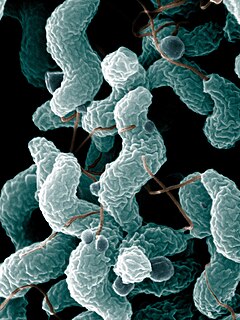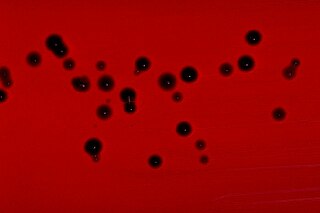
Campylobacter jejuni is one of the most common causes of food poisoning in Europe and in the US. The vast majority of cases occur as isolated events, not as part of recognized outbreaks. Active surveillance through the Foodborne Diseases Active Surveillance Network (FoodNet) indicates that about 20 cases are diagnosed each year for each 100,000 people in the US, while many more cases are undiagnosed or unreported; the CDC estimates a total of 1.5 million infections every year. The European Food Safety Authority reported 246,571 cases in 2018, and estimated approximately nine million cases of human campylobacteriosis per year in the European Union.
Multilocus sequence typing (MLST) is a technique in molecular biology for the typing of multiple loci, using DNA sequences of internal fragments of multiple housekeeping genes to characterize isolates of microbial species.

Staphylococcus haemolyticus is a member of the coagulase-negative staphylococci (CoNS). It is part of the skin flora of humans, and its largest populations are usually found at the axillae, perineum, and inguinal areas. S. haemolyticus also colonizes primates and domestic animals. It is a well-known opportunistic pathogen, and is the second-most frequently isolated CoNS. Infections can be localized or systemic, and are often associated with the insertion of medical devices. The highly antibiotic-resistant phenotype and ability to form biofilms make S. haemolyticus a difficult pathogen to treat. Its most closely-related species if Staphylococcus borealis.

Carbol fuchsin, carbol-fuchsin, carbolfuchsin, or Castellani's paint is a mixture of phenol and basic fuchsin that is used in bacterial staining procedures. It is commonly used in the staining of mycobacteria because it has an affinity for the mycolic acids found in their cell membranes.
Bartonellosis is an infectious disease produced by bacteria of the genus Bartonella. Bartonella species cause diseases such as Carrión's disease, trench fever, cat-scratch disease, bacillary angiomatosis, peliosis hepatis, chronic bacteremia, endocarditis, chronic lymphadenopathy, and neurological disorders.

Protothecosis, otherwise known as Algaemia, is a disease found in dogs, cats, cattle, and humans caused by a type of green alga known as Prototheca that lacks chlorophyll and enters the human or animal bloodstream. It and its close relative Helicosporidium are unusual in that they are actually green algae that have become parasites. The two most common species are Prototheca wickerhamii and Prototheca zopfii. Both are known to cause disease in dogs, while most human cases are caused by P. wickerhami. Prototheca is found worldwide in sewage and soil. Infection is rare despite high exposure, and can be related to a defective immune system. In dogs, females and Collies are most commonly affected.

Alcaligenes is a genus of Gram-negative, aerobic, rod-shaped bacteria. The species are motile with amphitrichous flagella and rarely nonmotile. It is a genus of non-fermenting bacteria. Additionally, some strains of Alcaligenes are capable of anaerobic respiration, but they must be in the presence of nitrate or nitrite; otherwise, their metabolism is respiratory and never fermentative; The genus does not use carbohydrates. Strains of Alcaligenes are found mostly in the intestinal tracts of vertebrates, decaying materials, dairy products, water, and soil; they can be isolated from human respiratory and gastrointestinal tracts and wounds in hospitalized patients with compromised immune systems. They are occasionally the cause of opportunistic infections, including nosocomial sepsis.

Chromobacterium violaceum is a Gram-negative, facultative anaerobic, non-sporing coccobacillus. It is motile with the help of a single flagellum which is located at the pole of the coccobacillus. Usually, there are one or two more lateral flagella as well. It is part of the normal flora of water and soil of tropical and sub-tropical regions of the world. It produces a natural antibiotic called violacein, which may be useful for the treatment of colon and other cancers. It grows readily on nutrient agar, producing distinctive smooth low convex colonies with a dark violet metallic sheen. Some strains of the bacteria which do not produce this pigment have also been reported. It has the ability to break down tarballs.
Mycobacterium bohemicum is a species of the phylum Actinomycetota, belonging to the genus Mycobacterium.
Mycobacterium senegalense is a species of Mycobacterium.
Ewingella americana is a Gram-negative rod, and the only species in the genus Ewingella. It was first identified and characterized in 1983. Ewingella is in the family Yersiniaceae. The organism is rarely reported as a human pathogen, though it has been isolated from a variety of clinical specimens, including wounds, sputum, urine, stool, blood, synovial fluid, conjunctiva, and peritoneal dialysate. The bacterium is named in honor of William H. Ewing, an American biologist who contributed to modern taxonomy.

Proteus penneri is a Gram-negative, facultatively anaerobic, rod-shaped bacterium. It is an invasive pathogen and a cause of nosocomial infections of the urinary tract or open wounds. Pathogens have been isolated mainly from the urine of patients with abnormalities in the urinary tract, and from stool. P. penneri strains are naturally resistant to numerous antibiotics, including penicillin G, amoxicillin, cephalosporins, oxacillin, and most macrolides, but are naturally sensitive to aminoglycosides, carbapenems, aztreonam, quinolones, sulphamethoxazole, and co-trimoxazole. Isolates of P. penneri have been found to be multiple drug-resistant (MDR) with resistance to six to eight drugs. β-lactamase production has also been identified in some isolates.
Campylobacter hyointestinalis is a species of Campylobacter implicated as a pathogen in gastroenteritis and diarrhoea in humans. It has been known to be transmitted from its usual host, the pig, to humans. In pigs, it is usually associated with proliferative ileitis, and found in conjunction with other species of that genus; however, it has also been isolated from hamster and cattle feces. It is catalase-positive, hydrogen sulfide-positive in the TSI slant, glycine-tolerant, and intolerant to 3.0% sodium chloride. It is able to grow at 25 °C, is sensitive to cephalothin, and resistant to nalidixic acid.
Enterobacter taylorae is a Gram-negative bacteria formerly known as Enteric Group 19, and also known as Enterobacter cancerogenus. Strains of E. taylorae are positive for: Voges-Proskauer, citrate utilization, arginine dihydrolase and malonate utilization. They ferment D-glucose and also ferment D-mannitol, L-rhamnose and cellobiose. They are negative for indole production, urea hydrolysis, lysine decarboxylase and fermentation of adonitol, D-sorbitol and raffinose. It occurs in human clinical specimens, being isolated from blood and from spinal fluid. It is known to cause infections and is not susceptible to penicillins nor cephalosporins.

Achromobacter xylosoxidans is a Gram-negative, aerobic, oxidase and catalase-positive, motile bacterium with peritrichous flagella, from the genus Achromobacter. It is generally found in wet environments. Achromobacter xylosoxidans can cause infections such as bacteremia, especially in patients with cystic fibrosis. In 2013, the complete genome of an A. xylosoxidans strain from a patient with cystic fibrosis was sequenced.

Helicobacter bilis is a bacterium in the Helicobacteraceae family, Campylobacterales order. It is a fusiform bacterium with three to 14 multiple bipolar sheathed flagella and periplasmic fibers wrapped around the cell. It is resistant to cephalothin and nalidixic acid, but sensitive to metronidazole. Like Helicobacter hepaticus, it colonizes the bile, liver, and intestine of mice, and is associated with multifocal chronic hepatitis and hepatocellular tumors.
Citrobacter farmeri is a Gram-negative species of bacteria.
Bartonella koehlerae is a bacterium first isolated from cats. Its genome consists of 1.7-1.8 Mb.
Pseudoglutamicibacter cumminsii is a species of Gram-positive bacteria.








